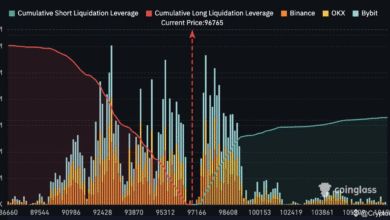Crypto Fear and Greed Index Today Master Bitcoin Market Psychology in 2025

Every successful cryptocurrency trader knows that markets are driven by two primary emotions: fear and greed. The crypto fear and greed index has revolutionized how investors approach Bitcoin and digital asset markets by transforming these powerful emotions into measurable, actionable data. This groundbreaking sentiment indicator has helped countless traders identify market bottoms during panic selling and recognize dangerous market tops when euphoria reaches unsustainable levels.
Understanding the crypto fear and greed index isn’t just about reading numbers—it’s about gaining a psychological edge that separates profitable traders from those who fall victim to crowd mentality. When retail investors panic-sell during extreme fear, smart money accumulates. When mainstream media celebrates new highs and everyone becomes a crypto expert, experienced traders prepare for corrections. The crypto fear and greed index quantifies these behavioral patterns, giving you the insights needed to profit from market psychology rather than become its victim.
What Makes the Crypto Fear and Greed Index Essential
The cryptocurrency market operates unlike any traditional financial market, creating unique opportunities for those who understand its psychological dynamics. Unlike stocks or bonds that trade during specific hours, crypto markets never sleep, amplifying emotional decision-making and creating more extreme sentiment swings.
The Emotional Rollercoaster of Crypto Trading
Cryptocurrency investors experience heightened emotional states due to several factors unique to digital assets. The extreme volatility means fortunes can be made or lost within hours, creating intense psychological pressure. Social media amplifies these emotions, with Twitter, Reddit, and Telegram communities either celebrating massive gains or lamenting devastating losses in real-time.
The crypto fear and greed index captures these emotional extremes by analyzing multiple data sources that reflect investor behavior. Rather than relying on subjective interpretations of market mood, the index provides objective measurements that remove emotional bias from decision-making processes.
Historical Context and Market Validation
Since its introduction, the crypto fear and greed index has demonstrated remarkable accuracy in identifying major market turning points. The index correctly signaled extreme fear during Bitcoin’s crash to $15,500 in November 2022, which preceded a significant relief rally. Similarly, extreme greed readings above 90 in late 2021 warned of the impending correction from Bitcoin’s all-time high near $69,000.
These historical validations aren’t coincidences—they reflect fundamental truths about human behavior in financial markets. When fear reaches extreme levels, even quality assets become oversold as panic selling overwhelms rational analysis. Conversely, extreme greed creates bubble conditions where investors ignore obvious risks in pursuit of quick profits.
Deep Dive: How the Index Works
The crypto fear and greed index combines six distinct data sources, each weighted according to its reliability and relevance to cryptocurrency market sentiment.
Volatility Analysis (25% Weight)
Bitcoin’s volatility compared to its 30-day and 90-day averages provides crucial insights into market stability and investor confidence. Higher-than-normal volatility typically indicates increased uncertainty and fear, while lower volatility suggests confidence and potentially complacent behavior.
The volatility component helps distinguish between healthy price discovery and panic-driven movements. During extreme fear periods, volatility spikes often accompany massive selling pressure as investors rush to exit positions regardless of price impact.
Market Momentum and Volume (25% Weight)
Current trading volumes and price momentum compared to recent averages reveal the intensity of market participation and directional conviction. Unusual volume spikes during price declines often indicate capitulation, while high volume during rallies can signal either healthy accumulation or distribution, depending on context.
This component helps identify when price movements reflect genuine sentiment shifts versus temporary noise. Sustained high volume during extreme fear readings often marks significant market bottoms, while declining volume during extreme greed periods may signal weakening uptrends.
Social Media Sentiment (15% Weight)
Real-time analysis of Twitter hashtags, post engagement, and cryptocurrency-related conversations provides immediate insights into public sentiment shifts. The algorithm analyzes not just the volume of mentions but the emotional tone and context of discussions.
Social media sentiment often leads price movements, making this component particularly valuable for early signal detection. When Twitter sentiment turns extremely negative during market corrections, it often precedes the most oversold conditions and subsequent rebounds.
Dominance and Market Health (10% Weight)
Bitcoin’s market capitalization dominance relative to altcoins serves as a broader market health indicator. During fearful periods, investors typically flee speculative altcoins in favor of Bitcoin, increasing its dominance percentage. Conversely, extreme greed often coincides with “altcoin seasons” where speculative assets outperform Bitcoin.
This metric helps distinguish between Bitcoin-specific sentiment and broader cryptocurrency market conditions, providing context for portfolio allocation decisions across different digital assets.
Surveys and Polling Data (15% Weight)
Direct sentiment surveys from cryptocurrency communities and trading platforms capture investor intentions and expectations. These surveys ask participants about their market outlook, investment plans, and risk tolerance levels.
While survey data can be subjective, aggregated responses from thousands of participants provide valuable insights into collective market psychology and potential behavioral shifts.
Google Trends Integration (10% Weight)
Search volume analysis for Bitcoin and cryptocurrency-related terms reveals public interest levels and the nature of information seeking. The algorithm specifically tracks the ratio of negative search terms (like “bitcoin crash” or “crypto scam”) to positive terms (like “bitcoin moon” or “crypto gains”).
Search trend analysis often provides early warnings of sentiment shifts, as increased searches for negative terms typically precede broader market awareness of problems or opportunities.
Reading the Index Like a Professional Trader

Professional interpretation of the crypto fear and greed index requires understanding both the numerical readings and the market context surrounding them.
Extreme Fear (0-25) The Contrarian’s Paradise
Extreme fear readings represent the most compelling buying opportunities in cryptocurrency markets, but they also require the most psychological fortitude to act upon. When the index drops below 25, it indicates widespread panic, capitulation, and often irrational selling pressure.
These conditions create what Warren Buffett famously described as being “greedy when others are fearful.” However, catching falling knives requires precise timing and risk management. Not every extreme fear reading marks an immediate bottom—sometimes markets remain fearful for extended periods before recovering.
The key to profiting from extreme fear lies in understanding the difference between rational concern and irrational panic. When negative news justifies some price decline but the market reaction seems disproportionate, extreme fear readings often identify optimal accumulation zones.
Fear Range (26-45) Cautious Opportunity
Fear readings indicate heightened anxiety without complete panic. These periods often present excellent risk-adjusted opportunities for patient investors willing to accumulate quality positions gradually. Unlike extreme fear, fear-range readings suggest markets retain some rationality while pessimism dominates sentiment.
Fear-range markets typically exhibit increased volatility, reduced trading volumes, and heightened sensitivity to news events. Smart investors use these conditions to build positions systematically while avoiding the knife-catching risks associated with extreme fear periods.
Neutral Zone (46-54) Information Gathering Mode
Neutral readings indicate balanced sentiment with roughly equal numbers of optimistic and pessimistic market participants. During these periods, the crypto fear and greed index provides limited directional guidance, making fundamental analysis and technical indicators more important for decision-making.
Neutral markets often coincide with consolidation phases, sideways trading ranges, or periods when no dominant narrative drives market sentiment. These phases can persist for weeks or months, testing the patience of traders seeking clear directional signals.
Greed Territory (55-74) Increasing Vigilance
Greed readings suggest rising optimism and increased risk-taking among investors. While positive sentiment can fuel continued price appreciation, greed periods require increased attention to risk management and position sizing.
During greed phases, markets often experience reduced volatility, increased participation from retail investors, and greater media attention. These conditions can sustain bull markets for extended periods but eventually lead to overvaluation concerns and increased correction risk.
Extreme Greed (75-100) Maximum Alert Status
Extreme greed indicates dangerous euphoria with investors potentially ignoring fundamental risks and valuation concerns. These readings historically precede major market peaks, making them ideal times for profit-taking and defensive positioning.
Extreme greed periods feature characteristics like widespread FOMO, speculative altcoin rallies, mainstream media hype, and dismissal of bearish perspectives. While markets can remain extremely greedy longer than many expect, these conditions are inherently unstable and typically resolve through significant corrections.
Advanced Trading Methodologies
Successful application of the crypto fear and greed index requires systematic approaches that combine sentiment analysis with proven risk management techniques.
The Sentiment-Based Accumulation Strategy
This methodology focuses on systematic buying during fear periods and strategic selling during greed phases:
Tier 1 Accumulation (Extreme Fear 0-25): Deploy 40-50% of available capital using large position sizes. Historical analysis suggests extreme fear provides the highest probability of substantial returns with acceptable risk levels.
Tier 2 Building (Fear 26-45): Continue regular purchases using 25-30% of available capital with moderate position sizes. Maintain a systematic approach while monitoring for trend continuation signals.
Tier 3 Maintenance (Neutral 46-54): Reduce new purchases to 10-15% of available capital while maintaining existing positions. Focus on portfolio rebalancing and preparation for directional signals.
Tier 4 Distribution (Greed 55-74): Begin systematic profit-taking using 20-25% of positions while maintaining core holdings. Increase cash reserves for future opportunities.
Tier 5 Protection (Extreme Greed 75-100): Implement aggressive profit-taking on 40-60% of positions while maintaining only the highest-conviction holdings. Maximize cash reserves for inevitable corrections.
Multi-Timeframe Sentiment Analysis
Professional traders combine daily index readings with longer-term trend analysis:
Weekly Smoothing: Calculate 7-day moving averages to filter daily noise and identify sustained sentiment trends. Weekly averages help distinguish temporary sentiment spikes from meaningful shifts.
Monthly Trending: Monitor monthly sentiment patterns to understand longer-term market cycles and psychological phases. Monthly analysis reveals seasonal patterns and cyclical behavior in cryptocurrency markets.
Divergence Analysis: Identify disconnections between price trends and sentiment readings. Bearish divergences occur when prices make new highs while sentiment weakens, suggesting potential trend exhaustion.
Real World Case Studies and Examples
Examining specific historical examples demonstrates the practical application and effectiveness of the crypto fear and greed index.
March 2020 COVID Crash
The March 2020 market crash provided a textbook example of extreme fear creating extraordinary opportunities. As global markets panicked over COVID-19 lockdowns, Bitcoin crashed from $10,000 to below $4,000 in a matter of days. The crypto fear and greed index reached extreme fear levels around 8-12 during the worst of the selling.
Traders who recognized this extreme reading as a buying opportunity and accumulated Bitcoin around $4,000-$6,000 levels saw their positions appreciate over 1,000% as Bitcoin rallied to $65,000 within 13 months. The key lesson: extreme fear often marks maximum opportunity, but requires conviction to act against overwhelming negative sentiment.
November 2021 Peak
The opposite extreme occurred in late 2021 as Bitcoin approached its all-time high near $69,000. The crypto fear and greed index consistently registered extreme greed readings above 80 throughout October and November 2021. Experienced traders recognized these extreme greed readings as warning signals and began systematic profit-taking.
When Bitcoin subsequently corrected to $15,500 by November 2022, those who heeded the extreme greed warnings preserved capital for future opportunities. This example demonstrates how extreme greed readings provide a warning of vulnerable market conditions, even if precise timing remains challenging.
May 2021 China Mining Ban
Bitcoin’s reaction to China’s cryptocurrency mining ban illustrated how external events can amplify sentiment extremes. When China announced its ban, Bitcoin dropped from $58,000 to $30,000, driving the fear and greed index to extreme fear levels around 15-20.
Traders who used this extreme fear reading as a buying signal benefited when Bitcoin recovered to new highs near $69,000 later that year. The China ban created temporary panic that disconnected price from fundamentals, creating exactly the type of opportunity the index is designed to identify.
Integration with Technical Analysis

The crypto fear and greed index achieves maximum effectiveness when integrated with traditional technical analysis methods.
Support and Resistance Confluence
Sentiment readings gain additional significance when they align with key technical levels. Extreme fear at major support zones often provides high-probability buying opportunities with clearly defined risk levels. Conversely, extreme greed at resistance levels increases the likelihood of trend reversals or significant corrections. Professional traders look for these confluence zones where sentiment extremes coincide with important technical levels, creating higher-probability trade setups with favorable risk-reward ratios.
Volume and Price Action Confirmation
Combining sentiment analysis with volume patterns provides additional confirmation for trading decisions. High-volume selling during extreme fear often indicates capitulation and marks significant bottoms. Low-volume rallies during extreme greed periods may suggest distribution and impending corrections.
Price action analysis helps distinguish between healthy corrections within uptrends and potentially more serious trend changes. When sentiment extremes align with key price action patterns, the probability of significant moves increases substantially.
Momentum and Oscillator Integration
Traditional momentum indicators like RSI, MACD, and Stochastic oscillators complement sentiment analysis by providing additional confirmation signals. Bullish divergences in momentum indicators during extreme fear periods often precede significant rallies, while bearish divergences during extreme greed phases warn of potential corrections.
Common Pitfalls and How to Avoid Them
Understanding frequent mistakes in applying the crypto fear and greed index helps improve trading outcomes and avoid costly errors.
The Timing Trap
The most common mistake involves expecting precise timing from sentiment indicators. Markets can remain in extreme sentiment states much longer than most traders anticipate, leading to premature entries or exits.
Solution: Use sentiment readings for general positioning guidance rather than precise timing signals. Implement systematic approaches that account for extended extreme periods rather than expecting immediate reversals.
Context Ignorance
Applying the index without considering broader market context, regulatory developments, or macroeconomic conditions can lead to poor decisions. External factors can override sentiment-based signals for extended periods.
Solution: Always evaluate sentiment readings within the context of fundamental developments, the regulatory environment, and broader financial market conditions. Sentiment analysis works best as one component of a comprehensive analytical framework.
Single Indicator Dependence
Relying exclusively on the fear and greed index while ignoring other valuable market information increases risk and reduces trading effectiveness.
Solution: Integrate sentiment analysis with technical indicators, fundamental research, on-chain metrics, and risk management principles. No single indicator, regardless of historical accuracy, should dominate decision-making processes.
Emotional Override
Ironically, some traders let emotions override the very sentiment signals designed to counteract emotional decision-making. When extreme fear readings suggest buying opportunities, fear prevents action. When extreme greed warnings suggest caution, greed ignores the signals.
Solution: Develop systematic approaches with predetermined rules for different sentiment readings. Pre-commitment to specific actions during sentiment extremes helps overcome emotional biases that prevent optimal decision-making.
Future Developments and Enhancements
The crypto fear and greed index continues evolving with improvements in data collection, analysis methodologies, and market coverage expansion.
Enhanced Data Sources
Future iterations may incorporate institutional trading flows, derivatives market data, and expanded social media monitoring to provide more comprehensive sentiment analysis. Integration of on-chain metrics and DeFi protocol activity could provide additional insights into market participant behavior.
Machine Learning Integration
Advanced algorithms could improve predictive capabilities by identifying subtle patterns in historical sentiment data and optimizing component weightings based on market conditions. Machine learning applications might enhance the index’s ability to distinguish between temporary sentiment spikes and meaningful trend changes.
Multi Asset Expansion
While currently focused on cryptocurrency markets, future versions might include sentiment analysis for individual digital assets, providing more granular insights for altcoin trading and portfolio management decisions.
Also Read: Master Cryptocurrency Swing Trading Course Complete Guide 2025
Conclusion
The crypto fear and greed index represents one of the most powerful tools available for understanding cryptocurrency market psychology and identifying profitable trading opportunities. By quantifying the emotions that drive market participants, this sentiment indicator provides unique insights that traditional analysis methods cannot capture.
Success with the crypto fear and greed index requires patience, discipline, and systematic implementation within a comprehensive trading framework. The index works best when combined with technical analysis, fundamental research, and rigorous risk management rather than used as a standalone decision-making tool.
The most profitable opportunities often arise when sentiment reaches extreme levels, but these situations also demand the greatest psychological fortitude to act against prevailing market emotions. Extreme fear creates buying opportunities that seem terrifying in the moment, while extreme greed generates selling signals that contradict euphoric market conditions.




